Theoretical and Empirical Verification of Electrical Impedance Matching Method for High-Power Transducers
Abstract
:1. Introduction
- Parameters of their circuit components corresponding to each matching circuit are derived based on experimental values probed by the impedance analyzer.
- To verify the electromechanical characteristics of the matched transducer, our equivalent circuit model is combined with proposed matching circuits.
- A hydrophone system is built to measure the acoustic pressure emitted from impedance-matched transducers for each matching scheme.
- Mechanical quality factor, Qm, is computed to evaluate the energy efficiency of the transducer.
- Both simulated and experimental results are compared to demonstrate the capability of our method to quantitatively design appropriate transducers for power generation.
2. Materials and Methods
2.1. Equivalent Circuit Models
2.2. Matching Circuits
2.2.1. Series L Circuit
2.2.2. LC Circuit
2.3. Experimental Setup
3. Results and Discussion
4. Conclusions
Author Contributions
Funding
Conflicts of Interest
References
- Milewski, A.; Kluk, P.; Kardyś, W.; Kogut, P. Modelling and designing of ultrasonic welding systems. Arch. Acoust. 2015, 40, 93–99. [Google Scholar] [CrossRef] [Green Version]
- Kogut, P.; Milewski, A.; Kardy, W.; Kluk, P.; Gawry, P. New multimode sonotrodes models designed for rotary ultrasonic welding systems. Acta Phys. Pol. A 2013, 124, 474–478. [Google Scholar] [CrossRef]
- Hussain, M.; Janajreh, I. Acousto-chemical analysis in multi-transducer sonochemical reactors for biodiesel production. Ultrason. Sonochem. 2018, 40, 184–193. [Google Scholar] [CrossRef]
- Patil, U.; Mokashe, N.; Shaha, J.; Arthekar, S.; Jagatap, H. Ultrasound-assisted improvements in biocatalytic activity and production of organic-solvent stable protease from Bacillus circulans MTCC 7942. Ultrason. Sonochem. 2018, 40, 201–205. [Google Scholar] [CrossRef]
- Price, G.; Tiong, T.; King, D. Sonochemical characterisation of ultrasonic dental descalers. Ultrason. Sonochem. 2014, 21, 2052–2060. [Google Scholar] [CrossRef] [Green Version]
- Ngo, Y.; Ripin, Z.; Yi, C.; Zaini Ridzwan, M.; Mamat Ali, W.; Awang, B. Development of an ultrasonic scalpel. IOP Conf. Ser. Mater. Sci. Eng. 2020, 815, 012014. [Google Scholar] [CrossRef]
- Newcomb, W.; Hope, W.; Schmelzer, T.; Heath, J.; Norton, H.; Lincourt, A.; Heniford, B.; Lannitti, D. Comparison of blood vessel sealing among new electrosurgical and ultrasonic devices. Surg. Endosc. 2009, 23, 90–96. [Google Scholar] [CrossRef]
- Kim, J.; Lee, J. Theoretical resonance analysis of Langevin transducers with equivalent circuit models for therapeutic ultrasound. J. Electr. Eng. Technol. 2019, 14, 2437–2445. [Google Scholar] [CrossRef]
- Kim, J.; Lee, J. Parametric study of bolt clamping effect on resonance characteristics of Langevin transducers with lumped circuit models. Sensors 2020, 20, 1952. [Google Scholar] [CrossRef] [Green Version]
- Upadhye, V.; Agashe, S. Effect of temperature and pressure variations on the resonant frequency of piezoelectric material. Meas. Control 2016, 49, 286–292. [Google Scholar] [CrossRef]
- Olfert, J.; Checkel, M.; Koch, C. Acoustic method for measuring the sound speed of gases over small path lengths. Sci. Instrum. 2007, 78, 054901. [Google Scholar] [CrossRef] [Green Version]
- Pershevska, L.; Drozdenko, O.; Drozdenko, K.; Leiko, O. Study of the influence of the housing on the cooling efficiency of the piezoceramic electroacoustic Langevin-type transducer. Technol. Audit Prod. Reserves 2021, 3, 50–55. [Google Scholar] [CrossRef]
- Cannata, J.; Ritter, T.; Chen, W.; Silverman, R.; Shung, K. Design of efficient, broadband single-element (20–80 MHz) ultrasonic transducers for medical imaging applications. IEEE Trans. Ultrason. Ferroelectr. Freq. Control 2003, 50, 1548–1557. [Google Scholar] [CrossRef] [PubMed]
- Lockwoood, G.; Turnball, D.; Christopher, D.; Foster, F. Beyond 30 MHz [applications of high-frequency ultrasound imaging]. IEEE Eng. Med. Biol. Mag. 1996, 15, 60–71. [Google Scholar] [CrossRef]
- Augustine, L.; Andersen, J. An algorithm for the design of transformerless broadband equalizers of ultrasonic transducers. J. Acoust. Soc. Am. 1979, 66, 629–635. [Google Scholar] [CrossRef]
- Dong, X.; Yuan, T.; Hu, M.; Shekhani, H.; Maida, Y.; Tou, T.; Uchino, K. Driving frequency optimization of a piezoelectric transducer and the power supply development. Rev. Sci. Instrum. 2016, 87, 105003. [Google Scholar] [CrossRef]
- Yang, Y.; Wei, X.; Zhang, L.; Yao, W. The effect of electrical impedance matching on the electromechanical characteristics of sandwiched piezoelectric ultrasonic transducers. Sensors 2017, 17, 2832. [Google Scholar] [CrossRef] [Green Version]
- Dumbrava, V.; Svilainis, L. Evaluation of the ultrasonic transducer electrical matching performance. Ultrasound 2007, 62, 16–21. [Google Scholar]
- Garcia-Rodriguez, M.; Garcia-Alvarez, J.; Yañez, Y.; Garcia-Hernandez, M.; Salazar, J.; Turo, A.; Chavez, J. Low cost matching network for ultrasonic transducers. Phys. Procedia 2010, 3, 1025–1031. [Google Scholar] [CrossRef] [Green Version]
- Makarov, O. Phenomenological method for broadband electrical matching of acousto-optical device piezotransducers. Opt. Eng. 1999, 38, 1127–1135. [Google Scholar] [CrossRef]
- Arnau, A.; Sogorb, T.; Jimenez, Y. A continuous motional series resonant frequency monitoring circuit and a new method of determining Butterworth-Van Dyke parameters of a quartz crystal microbalance in fluid media. Rev. Sci. Instrum. 2000, 71, 2563–2571. [Google Scholar] [CrossRef]
- Mason, W. Electromechanical Transducers and Wave Filters; D. Van Nostrand: New York, NY, USA, 1942. [Google Scholar]
- Krimholtz, R.; Leedom, D.; Mattaei, G. New equivalent circuits for elementary piezoelectric transducer. Electron. Lett. 1970, 6, 398–399. [Google Scholar] [CrossRef]
- Jin, H.; Dong, S.; Luo, J.; Milne, W. Generalised Butterworth-Van Dyke equivalent circuit for thin-film bulk acoustic resonator. Electron. Lett. 2011, 47, 424–426. [Google Scholar] [CrossRef]
- Sherrit, S.; Leary, S.; Bar-Cohen, Y.; Dolgin, B. Analysis of the impedance resonance of piezoelectric stacks. In Proceedings of the IEEE Ultrasonics Symposium, San Juan, PR, USA, 22–25 October 2000; pp. 1037–1040. [Google Scholar]
- Lin, S.; Xu, J. Effect of the matching circuit on the electromechanical characteristics of sandwiched piezoelectric transducers. Sensors 2017, 17, 329. [Google Scholar] [CrossRef]
- Rathod, V. A review of electric impedance matching techniques for piezoelectric sensors, actuators and transducers. Electronics 2019, 8, 169. [Google Scholar] [CrossRef] [Green Version]
- Alibakhshikenari, M.; Virdee, B.; Azpilicueta, L.; See, C.; Abd-Alhameed, R.; Althuwayb, A.; Falcone, F.; Huynen, I.; Denidni, T.; Limiti, E. Optimum power transfer in RF front end systems using adaptive impedance matching technique. Sci. Rep. 2021, 11, 11825. [Google Scholar] [CrossRef] [PubMed]
- Couraud, B.; Vauche, R.; Daskalakis, S.; Flynn, D.; Deleruyelle, T.; Kussener, E.; Assimonis, S. Internet of things: A review on theory based impedance matching techniques for energy efficient RF systems. J. Low Power Electron. Appl. 2021, 11, 16. [Google Scholar] [CrossRef]
- Sibanda, M.; Janse Van Rensburg, P.; Ferreira, H. Impedance matching with low-cost, passive components for narrowband PLC. In Proceedings of the IEEE International Symposium on Power Line Communications and Its Applications, Udine, Italy, 3–6 April 2011. [Google Scholar]
- Yuan, T.; Dong, X.; Shekhani, H.; Li, C.; Maida, Y.; Tou, T.; Uchino, K. Driving an inductive piezoelectric transducer with class E inverter. Sens. Actuator A Phys. 2017, 261, 219–227. [Google Scholar] [CrossRef]
- Anas, A.; Resmi, R. Electrode optimization for enhancement of Q-factor in SAW resonators. In Proceedings of the 2nd International Conference on Trends in Electronics and Informatics, Tirunelveli, India, 11–12 May 2018. [Google Scholar]
- Mertz, J.; Marti, O.; Mlynek, J. Regulation of a microcantilever response by force feedback. Appl. Phys. Lett. 1993, 62, 2344. [Google Scholar] [CrossRef]
- Steeneken, P.; Phan, K.; Goossens, M.; Koops, G.; Brom, G.; van der Avoort, C.; van Beek, J. Piezoresistive heat engine and refrigerator. Nat. Phys. 2011, 7, 354–359. [Google Scholar] [CrossRef]
- Beltran, N.; Finger, R.; Santiago-Aviles, J.; Espinoza-Vallejos, P. Effect of parasitic capacitances on impedance measurements in microsensors structures: A numerical study. Sens. Actuators B Chem. 2003, 96, 139–143. [Google Scholar] [CrossRef]
- Zhang, S.; Wang, Q.; Lin, T.; Zhang, P.; He, P.; Paik, K. Cu-Cu joining using citrate coated ultra-small nano-silver pastes. J. Manuf. Process. 2021, 62, 546–554. [Google Scholar] [CrossRef]
- Wang, Q.; Zhang, S.; Lin, T.; Zhang, P.; He, P.; Paik, K. Highly mechanical and high-temperature properties of Cu-Cu joints using citrate coated nano-sized Ag paste in air. Prog. Nat. Sci. Mater. 2021, 31, 129–140. [Google Scholar] [CrossRef]
- Lubbe, J.; Troger, L.; Torbrugge, S.; Bechstein, R.; Richter, C.; Kuhnle, A.; Reichling, M. Achieving high effective Q-factors in ultra-high vacuum dynamic force microscopy. Meas. Sci. Technol. 2010, 21, 125501. [Google Scholar] [CrossRef]
- Jian, X.; Li, Z.; Han, Z.; Xu, J.; Liu, P.; Cui, Y.; Huang, W. The study of cable effect on high-frequency ultrasound transducer performance. IEEE Sens. J. 2018, 18, 5265–5271. [Google Scholar] [CrossRef]
- Daft, C.; Wagner, P.; Bymaster, B.; Panda, S.; Patel, K.; Ladabaum, I. cMUTs and electronics for 2D and 3D imaging: Monolithic integration, in-handle chip sets and system implications. In Proceedings of the IEEE Ultrasonics Symposium, Rotterdam, The Netherlands, 18–21 September 2005. [Google Scholar]
- Zhang, Z.; Li, F.; Chen, R.; Zhang, T.; Cao, X.; Zhang, S.; Shrout, T.; Zheng, H.; Shung, K.; Humayun, M. High-performance ultrasound needle transducer based on modified PMN-PT ceramic with ultrahigh clamped dielectric permittivity. IEEE Trans. Ultrason. Ferroelectr. Freq. Control 2018, 65, 223–230. [Google Scholar] [CrossRef]


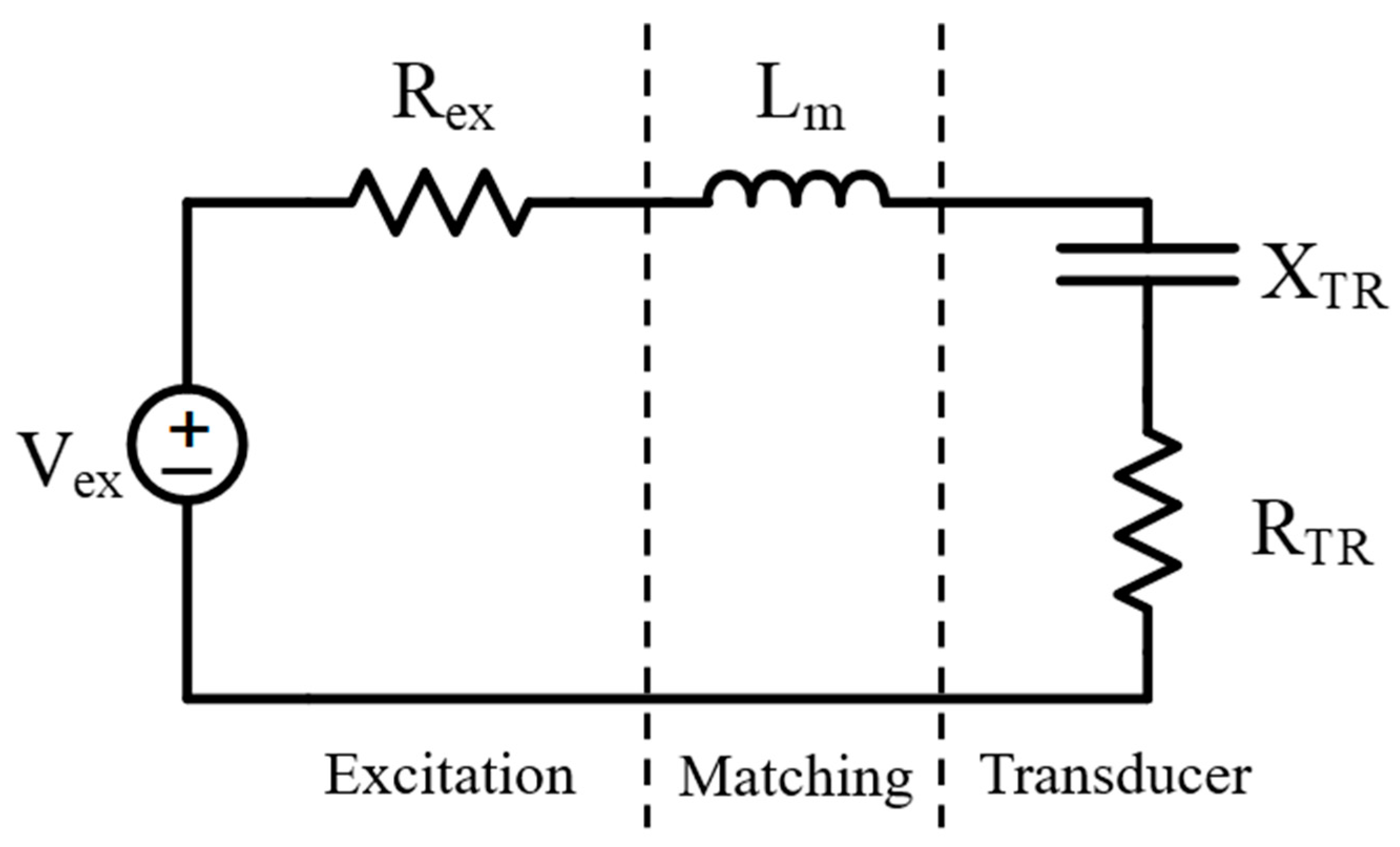
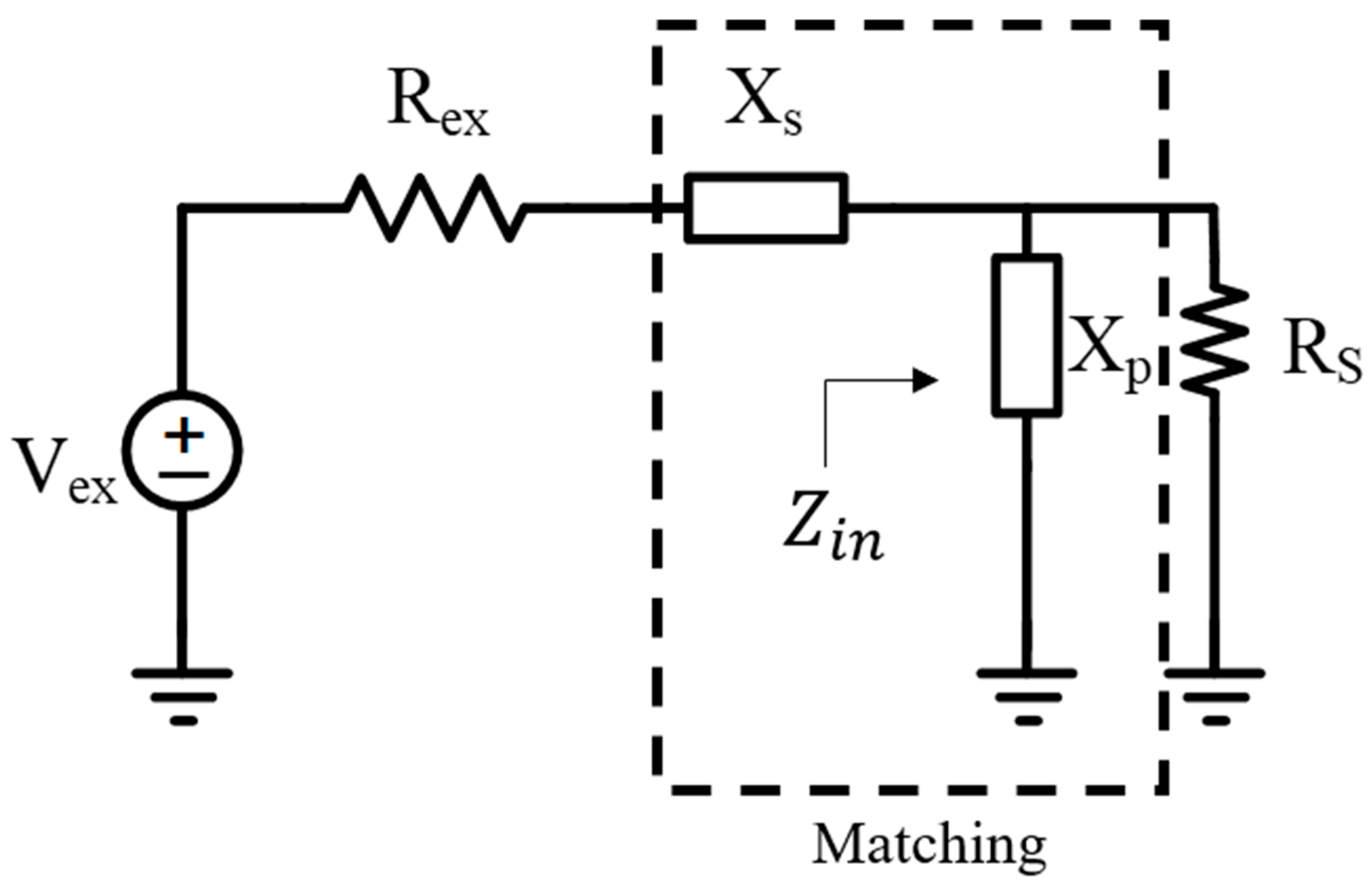
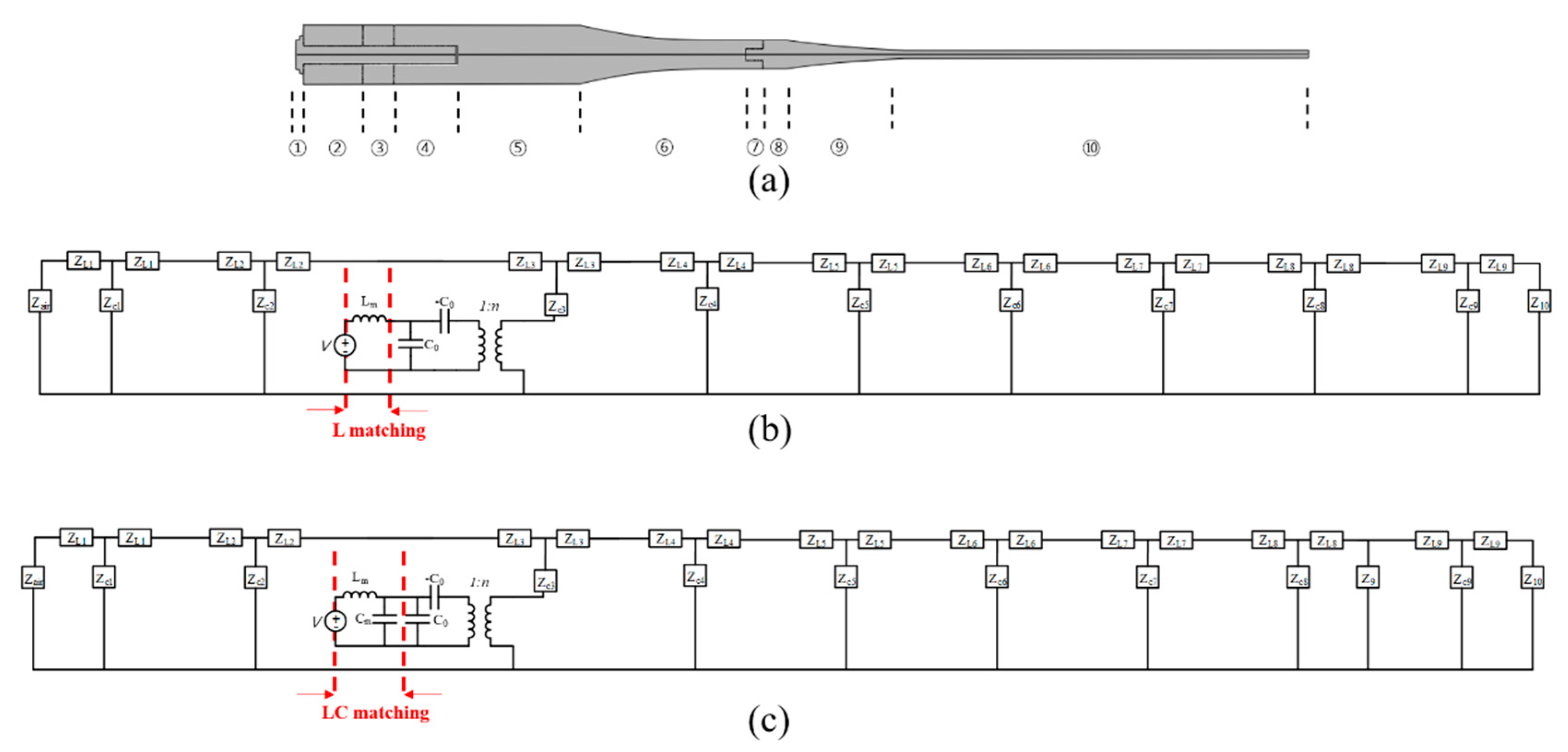
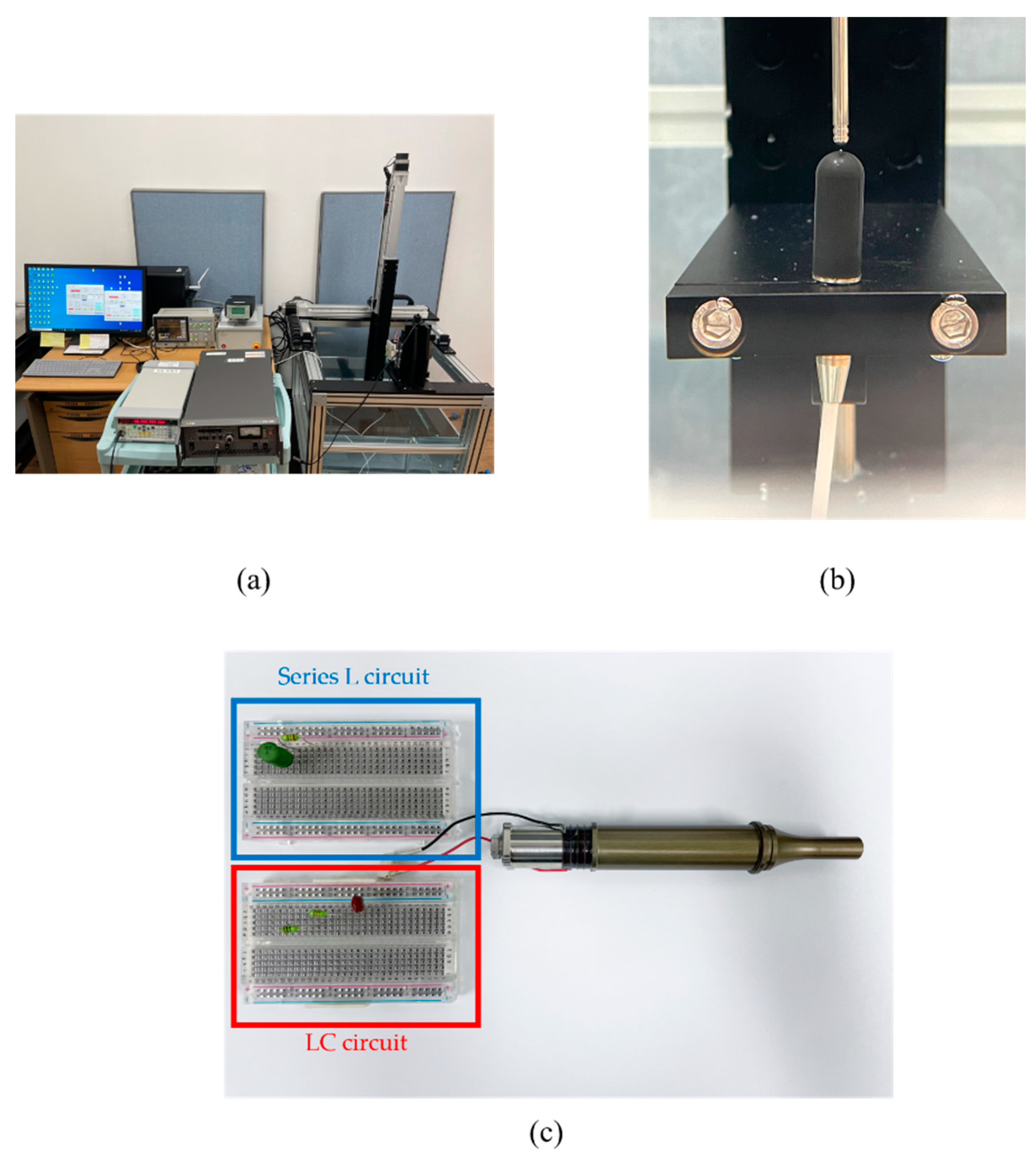

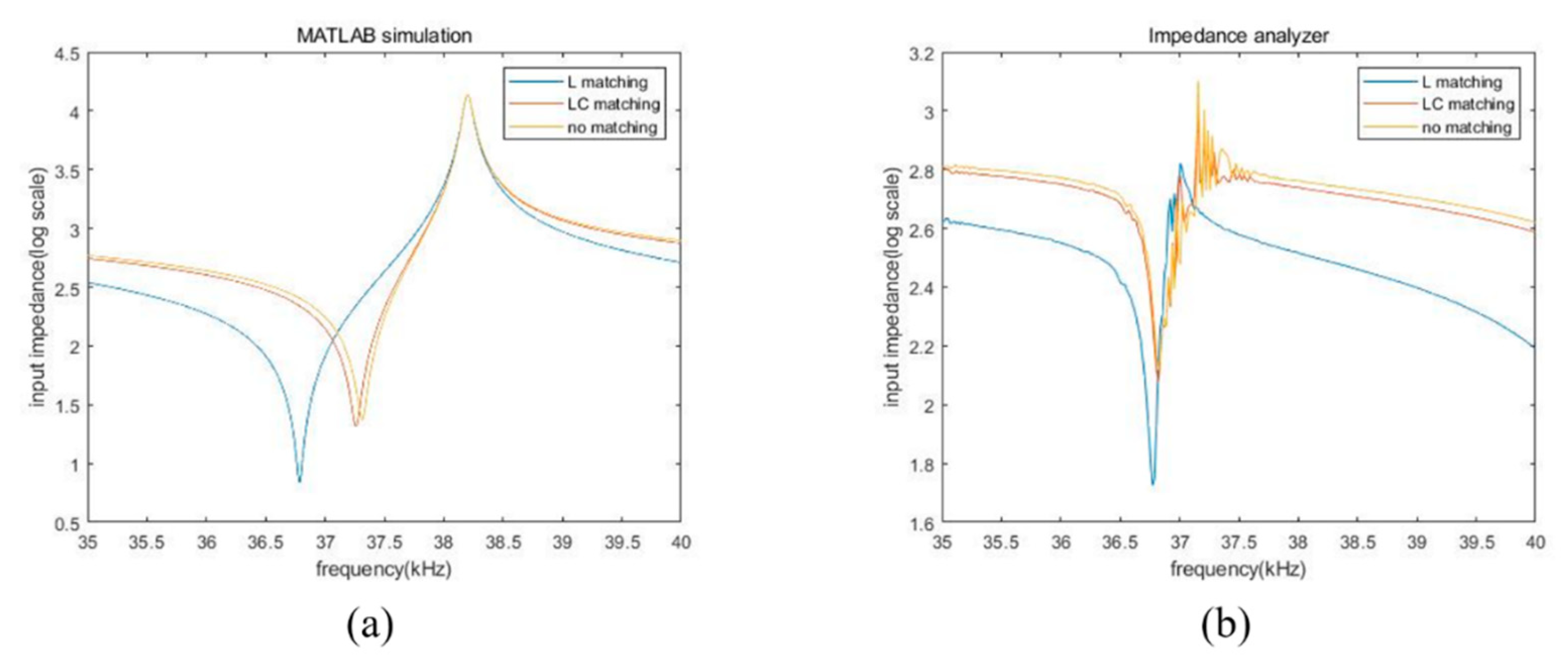
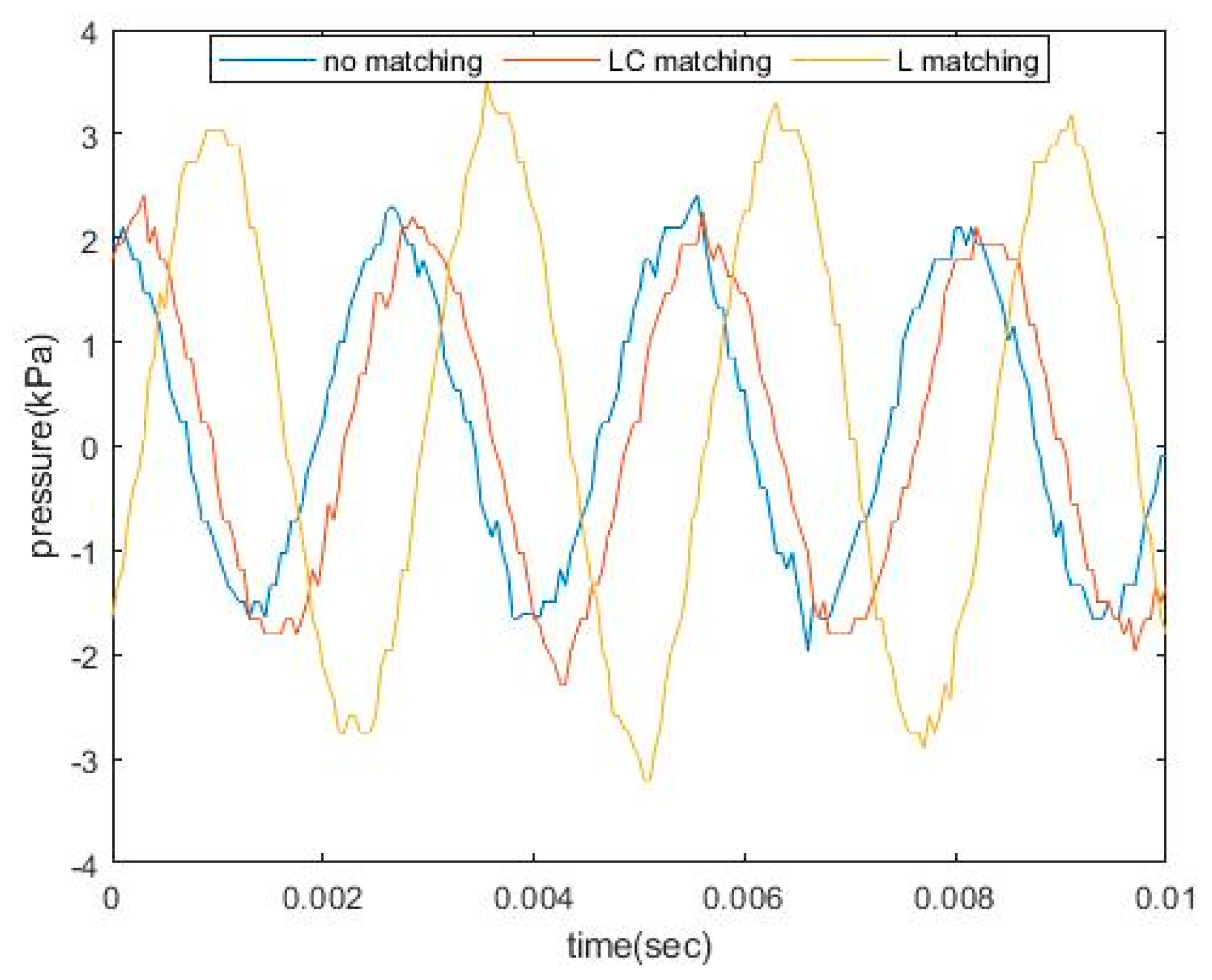


| Non-Matching | LC Matching | Series L Matching | |
|---|---|---|---|
| fr (kHz) | 37.31 | 37.26 | 36.79 |
| fa (kHz) | 38.20 | 38.20 | 38.20 |
| Impedance (fr) (Ω) | 23.59 | 20.67 | 6.97 |
| Impedance (fa) (kΩ) | 13.7 | 13.7 | 13.7 |
| Qm | 217.27 | 234.51 | 461.66 |
| Non-Matching | LC Matching | Series L Matching | |
|---|---|---|---|
| fr (kHz) | 36.82 | 36.82 | 36.77 |
| fa (kHz) | 37.16 | 37.16 | 37.01 |
| Impedance (fr) (Ω) | 131.36 | 120.25 | 53.17 |
| Impedance (fa) (kΩ) | 1.26 | 1.00 | 0.66 |
| Qm | 111.95 | 122.30 | 394.79 |
| 50 Vpp | 60 Vpp | 70 Vpp | 80 Vpp | 90 Vpp | 100 Vpp | |
|---|---|---|---|---|---|---|
| LC matching | 1.12 | 1.10 | 1.00 | 1.00 | 1.17 | 1.07 |
| Series L matching | 1.50 | 1.30 | 1.55 | 1.50 | 1.50 | 1.50 |
Publisher’s Note: MDPI stays neutral with regard to jurisdictional claims in published maps and institutional affiliations. |
© 2022 by the authors. Licensee MDPI, Basel, Switzerland. This article is an open access article distributed under the terms and conditions of the Creative Commons Attribution (CC BY) license (https://creativecommons.org/licenses/by/4.0/).
Share and Cite
Lee, J.; Kim, J. Theoretical and Empirical Verification of Electrical Impedance Matching Method for High-Power Transducers. Electronics 2022, 11, 194. https://doi.org/10.3390/electronics11020194
Lee J, Kim J. Theoretical and Empirical Verification of Electrical Impedance Matching Method for High-Power Transducers. Electronics. 2022; 11(2):194. https://doi.org/10.3390/electronics11020194
Chicago/Turabian StyleLee, Jungwoo, and Jinhyuk Kim. 2022. "Theoretical and Empirical Verification of Electrical Impedance Matching Method for High-Power Transducers" Electronics 11, no. 2: 194. https://doi.org/10.3390/electronics11020194
APA StyleLee, J., & Kim, J. (2022). Theoretical and Empirical Verification of Electrical Impedance Matching Method for High-Power Transducers. Electronics, 11(2), 194. https://doi.org/10.3390/electronics11020194






